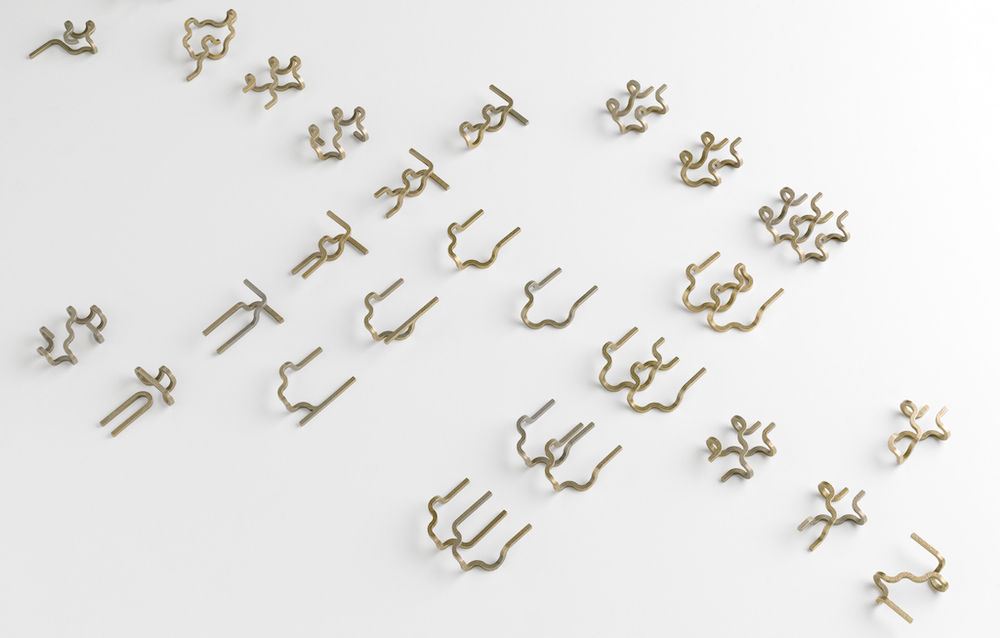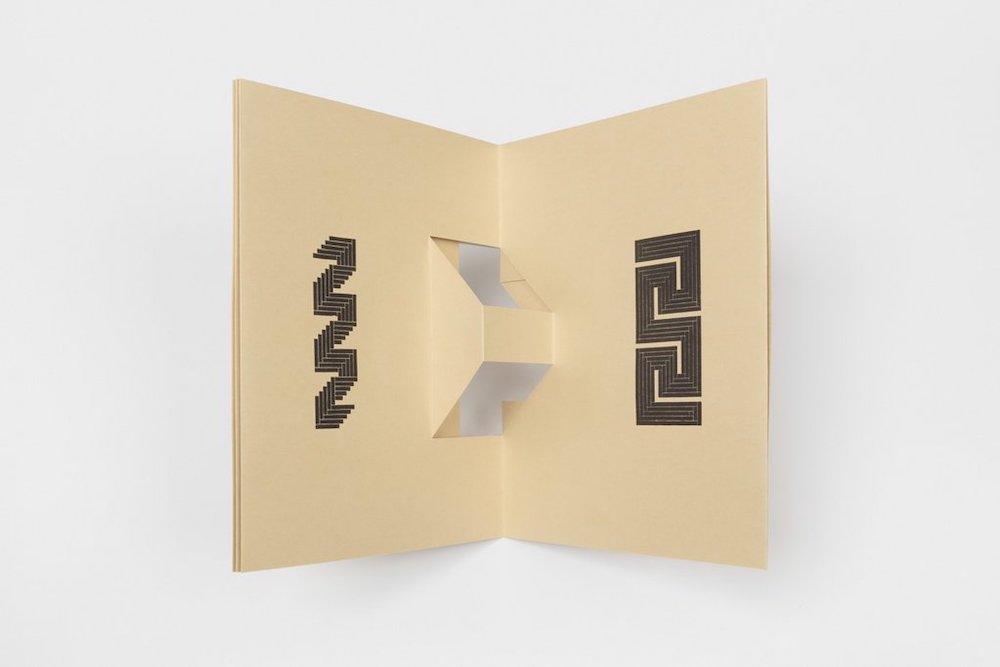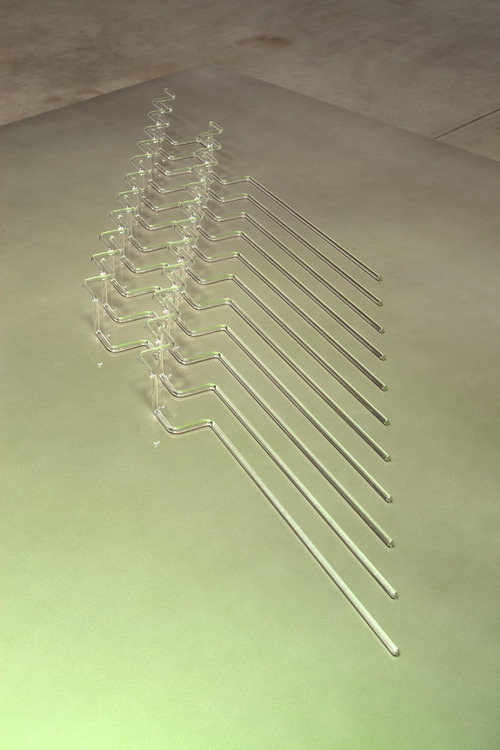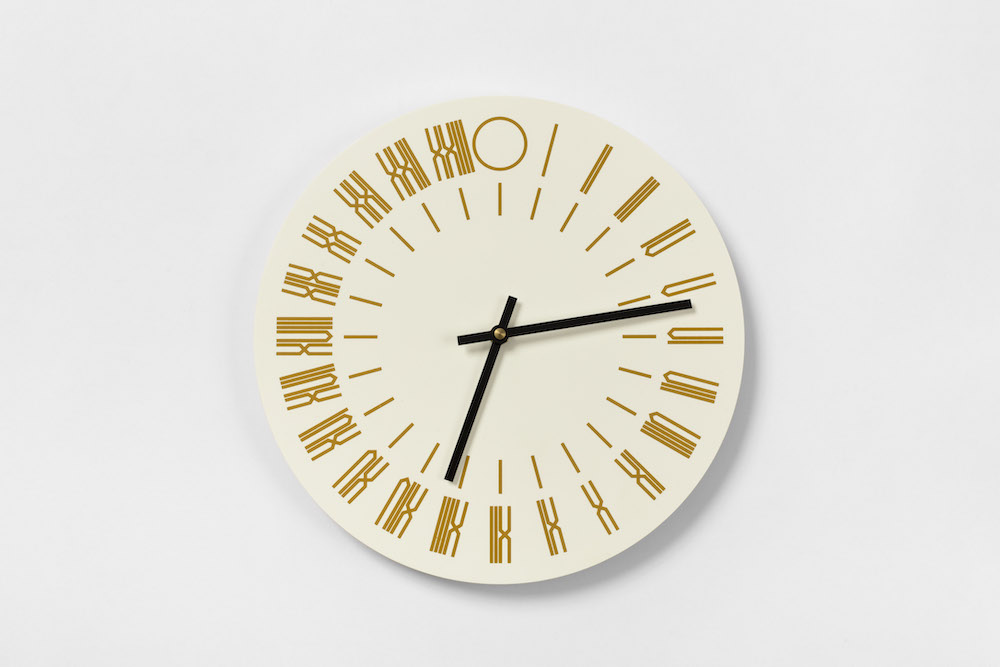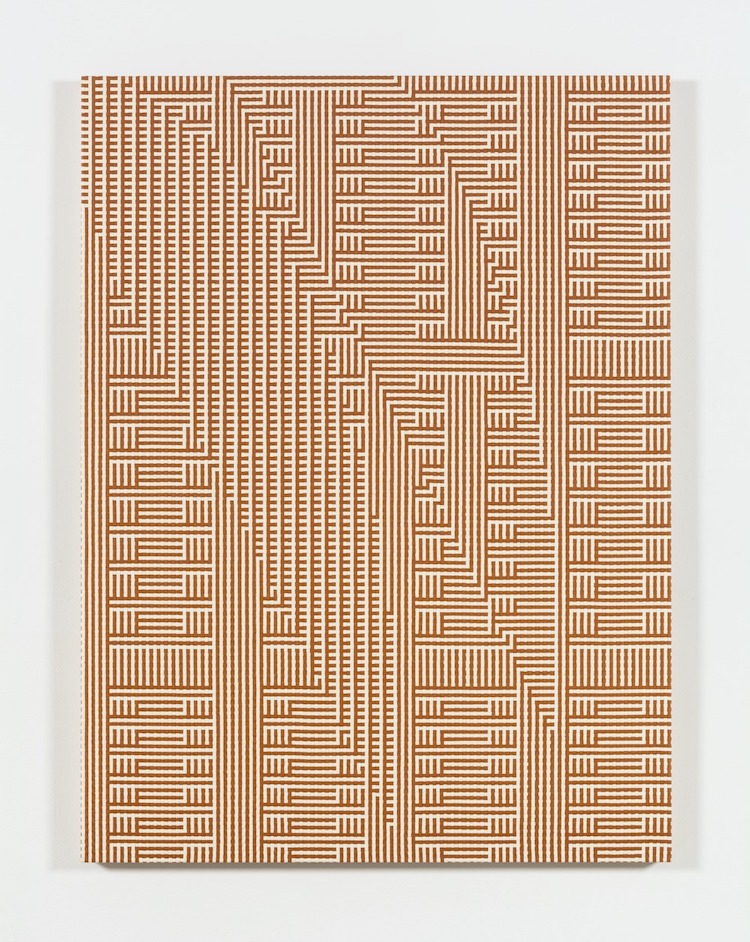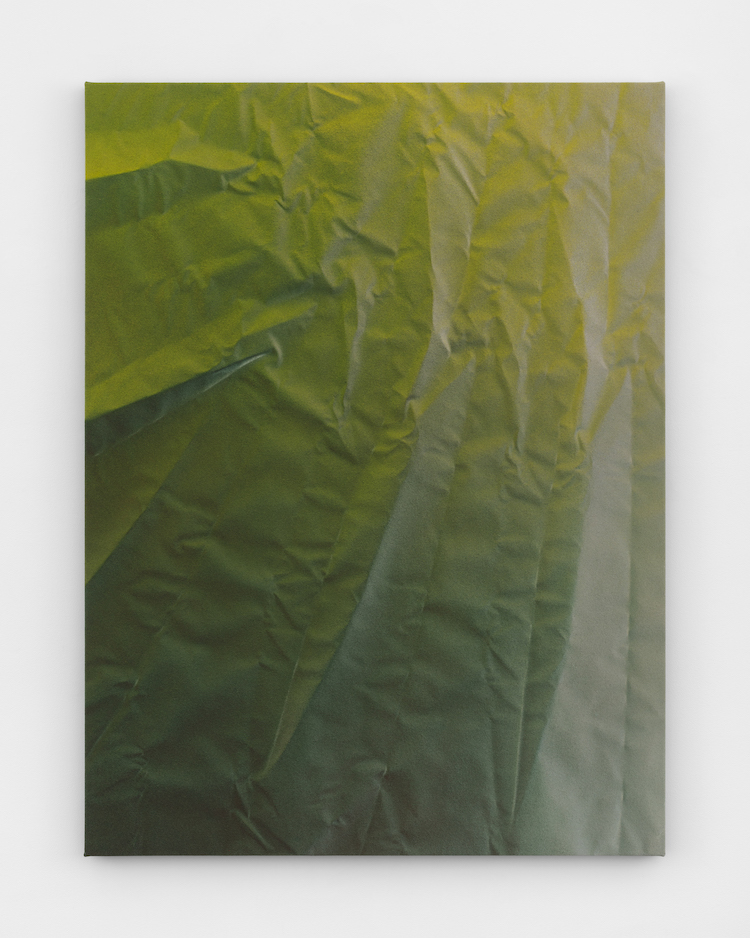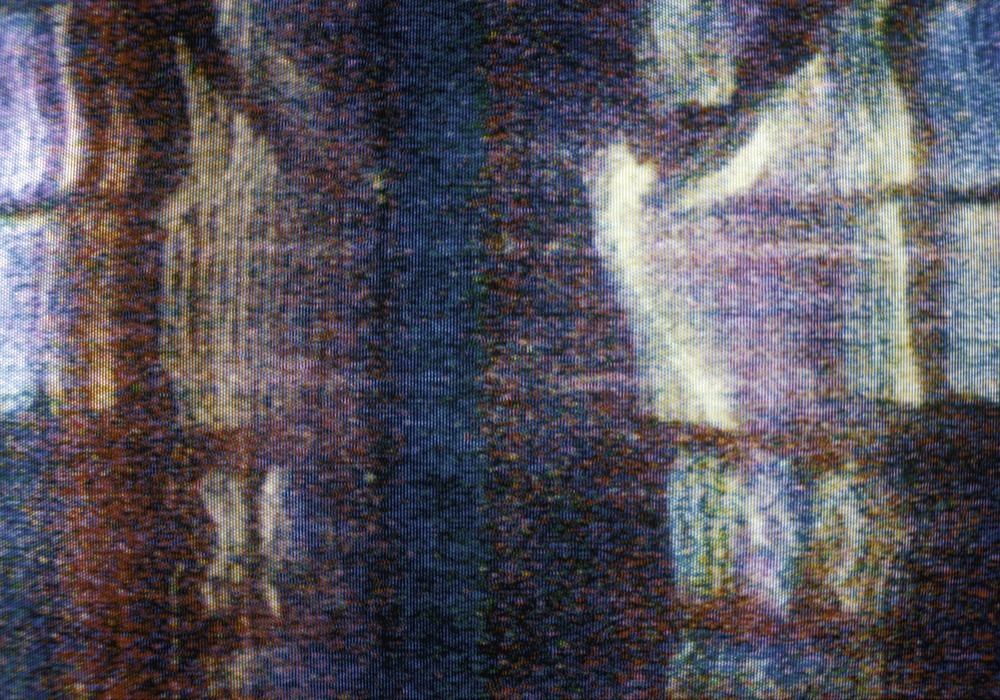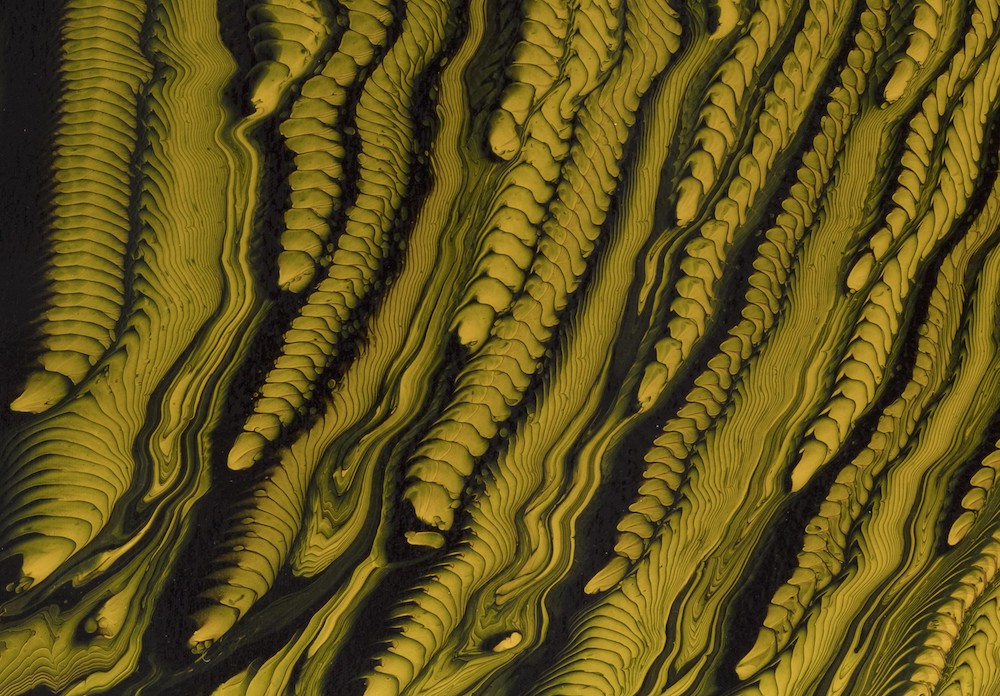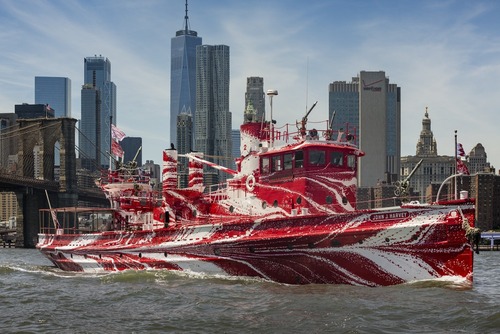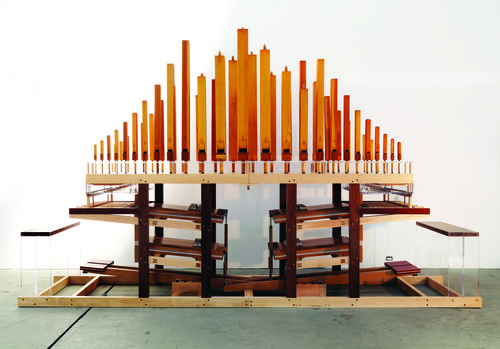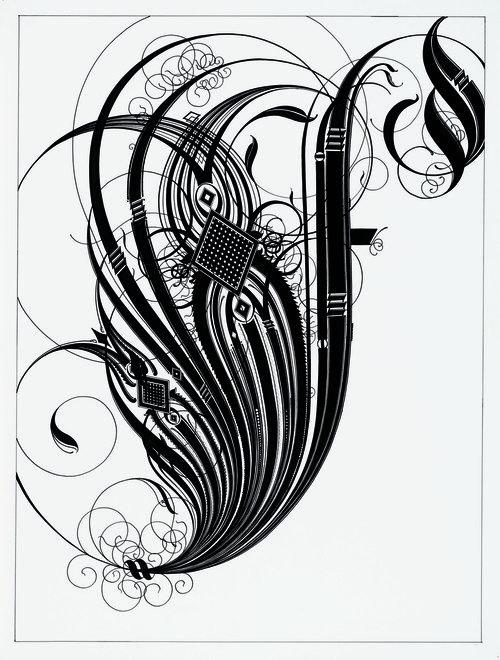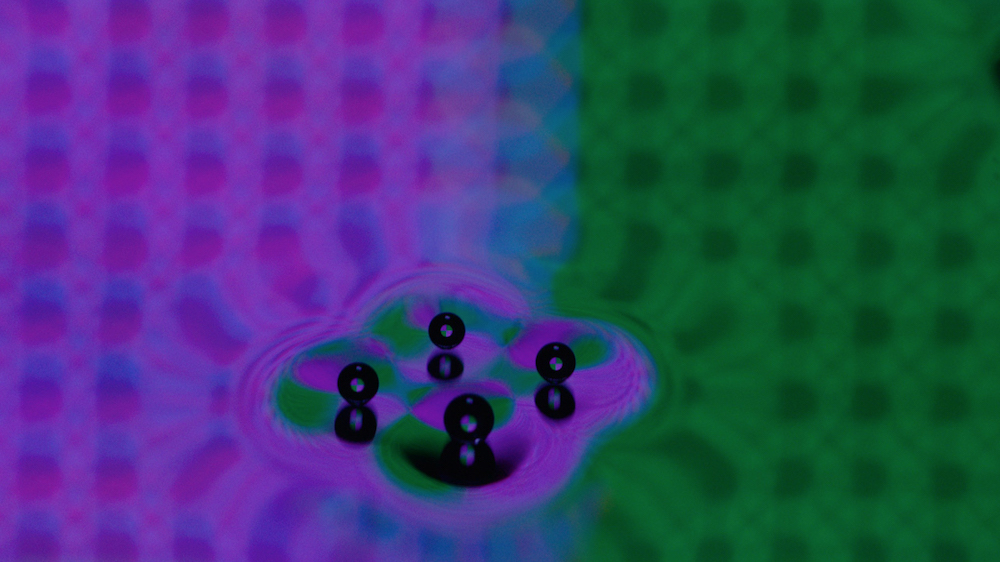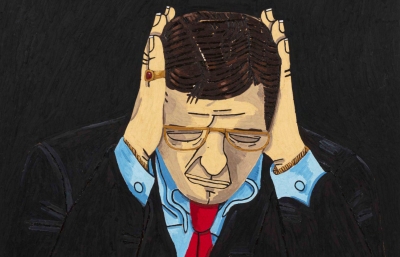“There are different kinds of beauty in mathematics. Some patterns are beautiful, but that is not what most mathematicians mean when they talk about the beauty of mathematics. For me, the beauty is the thrilling conceptual elegance which often involves elements of surprise, economy, depth, relevance and power.” This from Alex Bellos, a British mathematics communicator by trade, and his words give insight into Tauba Auerbach’s S v Z, currently showing at the San Francisco Museum of Modern Art. Walk through this truly interdisciplinary exhibition, and rest assured that even the math-phobes among us will appreciate the beauty and wonder in Auerbach’s work as she shares the revelations of an artist with a most inquiring mind.
The letters “S” and “Z” equate to the two possible directions of the helix, a form that literally spirals throughout the show, as well as “our” universe, letter forms that wend their way throughout the exhibit. The show discourages a linear route, encouraging a wending through the wing, starting with Flow Separation, a larger reimagining of her 2018 red and white dazzle camouflage on a NYC Fireboat. Here, with help from New Bohemia Signs, the mural, a flowing curtain of black ink, marbled over sheets of white paper and visible from various rooms, pulls us in like an ocean spray. Within, the Folds paintings defy dimensionality; The Weaves concentrate pattern and structure and play with light within the confines of canvas; the Grain paintings emerge from colorful, customized tools; Sculptures, album covers; Through the chromogenic prints Static 12-15, the artist sought stochasticity (randomness) and found patterns. A highlight is the Auerglass Organ, which started out as a banjo and cookie tin pressed into service on a night of “friendship and boredom” and is now a polished wood wonder that depends on each of two players relying on the other to pump air into each other’s pipes. The Scottish journalist Cal Flynn wrote that, “For an experienced mathematician, the greatest equations are beautiful as well as useful. Can the rest of us see what they see?” Auerbach gives us boost, so when someone creates their own Exploratorium, there are questions. 
Gwynned Vitello: I think I’d fail at writing a Wikipedia page encompassing you as an artist. There’s no one genre, and it’s as if you embody the open-minded, unbridled, wide open eyes of a curious child, set out to explore the world, but with the ability to package your experience with process and discipline. Going way back, describe a vivid image grafted in your memory bank, what combinations of color and shape?
Tauba Auerbach: I had a lot of vivid nightmares as a kid, and the scariest one was totally abstract - a projected square of light crumpled up into oblivion and then appearing afresh, over and over again in an ominous rhythm. The rhythm was the scary thing. Nothing bad happened, but it was a very sinister intervall. This is probably not as fantastical in the way you imagined!
Excuse the deficient sounding term “only child”, but maybe because you were alone in your bedroom? Tell me about the advantages of growing up without siblings, how did you spend your time?
I had long periods of amusing myself alone, often when my parents were working; so I’d raid the office supply closet and make things with whatever I found in there - often little books. I did a lot of puzzles. I think not having siblings wired me to be quite comfortable with alone time, which is an advantage. But there are downsides, since I do find it hard to focus or make decisions with other people around.
When did you know you wanted to study visual arts and how did classes at Stanford prepare, or maybe, redirect your course?
I always made things - designed, built and decorated stuff, always customized my environment and my clothing. So I always knew I would be a maker of some kind. Of course, this could take so many forms, there are so many modes of making and so many possible motives that could guide a person. You have to ask yourself - Do you want to make things that simply look good? That mean something? That solve a practical problem? What is “meaning” anyway? Along with those questions, I’m constantly still asking myself how much more “stuff” really needs to exist, what is worth itself in materials and effort and the space it takes up?
Anyway, I decided not to go to art school because I still didn’t know what kind of maker I wanted to be and I also wanted access to math and science courses. I did a year of the mechanical engineering degree, and it was the most fun I ever had in school; but it showed me that I didn’t want that to be my career. I didn’t want to be a designer or strictly a problem solver. I wanted to make things that addressed baffling, probably unresolvable questions. 
And then you went to work at New Bohemia signs in San Francisco. That must have been, and still is, a big influence on your professional career.
When I left school I was sure that I wanted to do a job with my hands, to learn a craft. This may sound like some kind of fetishistic turn away from the intellectual, but that’s not at all the case. I learn more through touch and doing than through reading and theorizing. There is so much wisdom contained in craft, in becoming sensitive to materials, in learning about their relationships to one another. I loved sign painting and I feel endlessly lucky to have worked at New Bohemia. Most of what I know about painting in any kind of technical way comes from my boss there, Damon Syer. I’m really happy we could paint together on the two big murals I’ve done in the last few years. One is in the Tenderloin in San Francisco and one is in the SFMOMA for this show. It’s a 1.1 scale reincarnation of the dazzle camo that I had previously painted on a fireboat in the New York City harbor.
Have you ever made any work in response to the look of musical notes? I don’t remember reading that you are a musician, but I can imagine you seeing a type of language in musical notes? And how did you get involved with making album covers?
Sometimes I think about one series of drawings, the Ligature drawings, like scores. Buddies of mine in the band Zs pointed out that some of them look a lot like neumes, which were an early type of musical notation, before the five line staff. Often they’re little inflective marks drawn above words to show how they can be sung. Not only do some of them look like neumes, the Ligature drawings are pretty rhythmic; there is often a repeating, wavelike line, and I alternate between heavy and light pressure. The pen makes a different swishing sound in all these modulations, so there are these little beats and patterns that I hear while I draw.
Well, continuing with music, I’m excited that the Auerglass Organ will be displayed and is scheduled to be performed in conjunction at the exhibit. Tell me how you and Cameron Mesirow (professionally known as Glasser) made “this really crappy banjo out of a cookie tin” which has evolved into a signature piece.
We really just started the project because we were roommates and were really bored one night. The first time Cameron and I hung out we were teenagers and we cut up and made new clothing out of stuff we didn’t like anymore and then wore it out. So I guess a project was always our idea of a good time! We made the banjo based on some instructions we found on the internet. We did a pretty bad job, but it was fun and it just turned into a conversation about making instruments and what a two-person instrument might look like. Over the next couple of years, the conversation evolved from an instrument that two people could play together to an instrument that would require two people to play cooperatively.
As an artist who experiments, who works with so many forms of art, how do you manage projects? One at a time so you work slowly and methodically, or are you able to juggle them?
Not one at a time, and far less methodically than I should. I have a ton of things going on in parallel always, and they are set up in different areas of the study. I basically spend the day bouncing between different zones, doing entirely different things. Sometimes I spray a background for a painting in the morning, go bend glass for a few hours, work in Illustrator, draw, return emails and then return to the foreground of the painting at the end of the day. That’s on a good day, when email doesn’t eat up half of my time.
Do you have a lot of input as to how your shows are curated, how they are hung? This particular show was supposed to open before Covid, so did you change your mind about how this iteration would look? Do you remember any shows with a particularly unique setting?
The curators at SFMOMA gave me a lot of room to hang this show in unusual ways. All of the freestanding objects are at a 30 degree angle to the walls, so there are two superimposed grids in the space. I also really wanted to use the vertical dimension, so there are custom vitrines that have stacked display surfaces and some works are hung up extremely high, while in general, the paintings are hung a bit lower than standard - which is something I really like because it makes them relate to your body, not just your eyeballs and head. We changed a few things about the installation during the covid delay, but the most significant changes were to texts. One of my favorite shows recently was a show that my friends Mundus Press (CHarlotte and Emma Kohlman) put on in a swamp.
Are you still exploring a new color dimension? Do you envision new colors at night when you can’t sleep? I’m curious if you’re comfortable wearing and living in color, and if so, do you have a favorite. I love all the shades of green.
I’m still trying to see some of the same old colors differently, to see a yellowish blue rather than a green. I wear colors - a lot of orange now. I used to hate navy blue and baby blue, and now I love them both. I enjoy changing my mind, and I love how unstable our relationship to color is.
Many artists have said that Covid did not make much difference in their practice because, by habit, they work alone. That might be true for you, but I imagine you have considered how we all kind of lost the proscribed sense of time. People will say that the last two years have dragged on and/or flown by concurrently. Did that affect your practice? Has it altered your perception of the passage of time?
My dad kept saying, “The days are long, but weeks are short!” all through 2020 and the more locked-down time. I thought it was a good description, though I’ve always found time totally impossible to understand. So this Covid distortion wasn’t novel to me. My sense of space was more impacted - being stationary and confined to a small space, but also having a shared experience with the entire globe! I don’t have profound words for it - it was, and is, just so weird. I guess my response was to zoom way out and way in. I started looking at and making maps of the earth, and my studio assistants and I did a big research project about the land the studio is on. We dug into this point in space going back in time and have a nearly complete timeline of it starting in 1647.
Speaking of “outer” space, I’ve read that you have dreamed of going up into the cosmos, but as much as that has been a dream, would you want to share it in the company of Elon Musk or Jeff Bezos?
In the abstract, I would absolutely love to go into space, but I wouldn’t do it under any of today’s circumstances. If someone offered me a ride on a very deep sea vessel - that, I’d be more likely to accept!
Tauba Auerbach - S v Z shows at the Museum of Modern Art through May 1, 2022.

